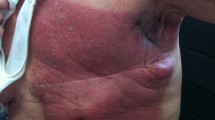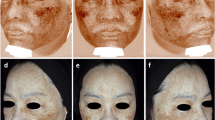Abstract
Radiodermatitis is visually evaluated by the Radiation Therapy Oncology Group (RTOG) scoring scheme, using characteristics such as erythema, desquamation, moist and bleeding. However, subjectivity and differences in skin types and melanin content may bias interpretation. This paper describes the use of RGB cameras for radiodermatitis estimation using image processing. We imaged radiodermatitis evolution throughout the treatment of 23 breast cancer radiotherapy patients of all Fitzpatrick skin phototypes. To prevent confounding information from skin fluids and skin reflection, we used cross-polarized imaging. RGB intensity was corrected using white medical tape as a reference. The RGB color as a function of RTOG grade depended strongly on skin phototype. Yet, when patients are grouped into white, brown, and black skin, the normalized RGB colors reveal stable characteristic signatures that uniquely predict RTOG grade for each group. We conclude cross-polarized RGB imaging as proposed is viable to document and estimate radiodermatitis on all skin phototypes.



Similar content being viewed by others
Explore related subjects
Discover the latest articles, news and stories from top researchers in related subjects.References
Baines CR, McGuiness W, O’Rourke GA (2016) An integrative review of skin assessment tools used to evaluate skin injury related to external beam radiation therapy. J Clin Nurs 26:1137–1144
Nystrom J, Geladi P, Lindholm-Sethson B, Larson J, Svensk AC, Franzen L (2008) Objective measurements of radiotherapy-induced erythema. Skin Res Technol 10:242–250
Jacques SL, Ramella-Roman JC, Lee K (2002) Imaging skin pathology with polarized light. J Biomed Opt 7(3):329–340
Seité S, Bensadoun RJ, Mazer JM (2017) Prevention and treatment of acute and chronic radiodermatitis. Breast Cancer: Targets Ther 9:551
Cox JD (1995) Toxicity criteria of the radiation therapy oncology group (RTOG) and the European organization for research and treatment of cancer (EORTC). Int J Radiat Oncol Biol Phys 31:1341–1346
Ahmad Fadzil MH, Ihtatho D, Mohd Affandi A, Hussein SH (2009) Objective assessment of psoriasis erythema for PASI scoring. J Med Eng Technol 33(7):516–524
Lahti A, Kopola H, Harila A, Myllylä R, Hannuksela M (1993) Assessment of skin erythema by eye, laser doppler flowmeter, spectroradiometer, two-channel erythema meter, and Minolta chromameter. Arch Dermatol Res 285(5):278–282
Sattler EC, Kästle R, Welzel J (2013) Optical coherence tomography in dermatology. J Biomed Optics 18(6):061224
Wong S, Kaur A, Back M, Lee KM, Baggarley S, Lu JJ (2011) An ultrasonographic evaluation of skin thickness in breast cancer patients after postmastectomy radiation therapy. Radiat Oncol 6(1):1–10
Warszawski A, Röttinger EM, Vogel R, Warszawski N (1998) 20 MHz ultrasonic imaging for quantitative assessment and documentation of early and late postradiation skin reactions in breast cancer patients. Radiother Oncol 47(3):241–247
Querleux B (2004) Magnetic resonance imaging and spectroscopy of skin and subcutis. J Cosmet Dermatol 3(3):156–161
Raina A, Hennessy R, Rains M, Allred J, Hirshburg JM, Diven DG, Markey MK (2016) Objective measurement of erythema in psoriasis using digital color photography with color calibration. Skin Res Technol 22(3):375–380
Setaro M, Sparavigna A (2002) Quantification of erythema using digital camera and computer-based colour image analysis: a multicentre study. Skin Res Technol 8(2):84–88
Abdlaty R, Haywar J, Farrell T, Fang Q (2020) Skin erythema and pigmentation optical assessment techniques. Photodiagn Photodyn Therapy 1:102127
Rubegni P, Cevenini G, Flori ML, Fimiani M, Stanghellini E, Molinu A, Barbini P, Andreassi L (1997) Relationship between skin color and sun exposure history: a statistical classification approach. Photochem Photobiol 65(2):347–351
Ben-Gashir MA, Seed PT, Hay RJ (2002) Reliance on erythema scores may mask severe atopic dermatitis in black children compared with their white counterparts. Br J Dermatol 147(5):920–925
Matsubara H, Matsufuji N, Tsuji H, Yamamoto N, Karasawa K, Nakajima M, Takahashi W, Karube M (2015) Objective assessment in digital images of skin erythema caused by radiotherapy. Med Phys 42(9):5568–5577
Tanaka S, Tsumura N (2020) Improved analysis for skin color separation based on independent component analysis. Artif Life Robot 25(1):159–166
Mustari A, Kanie T, Kawauchi S, Sato S, Sato M, Kokubo Y, Nishidate I (2018) In vivo evaluation of cerebral hemodynamics and tissue morphology in rats during changing fraction of inspired oxygen based on spectrocolorimetric imaging technique. Int J Mol Sci 19(2):491
Acknowledgements
We thank Dr. Alexandre Faustino, MD, of the Ribeirao Preto Medical School Hospital (University of Sao Paulo) for discussions on the classification of radiodermatitis grades.
Funding
This study was financed in part by the Coordenação de Aperfeiçoamento de Pessoal de Nível Superior—Brazil (CAPES)—Finance Code 001. GCC ORCID 0000-0001-8459-9812, JFP ORCID: 0000-0002-1647-8231.
Author information
Authors and Affiliations
Corresponding author
Ethics declarations
Ethics approval
This study was approved by FFCLRP/HC-FMRP/University of Sao Paulo Ethics Committee (certificate CAAE 73541017.20000.5407) and complies with the Declaration of Helsinki. All volunteering patients provided informed consent before participation in the study, and no patient received financial compensation for the study.
Additional information
Publisher's Note
Springer Nature remains neutral with regard to jurisdictional claims in published maps and institutional affiliations.
About this article
Cite this article
Verdugo-Naranjo, I., Hamamura, A.C., Arruda, G.V. et al. Radiodermatitis grade estimation by RGB color imaging. Artif Life Robotics 27, 58–63 (2022). https://doi.org/10.1007/s10015-022-00739-w
Received:
Accepted:
Published:
Issue Date:
DOI: https://doi.org/10.1007/s10015-022-00739-w




